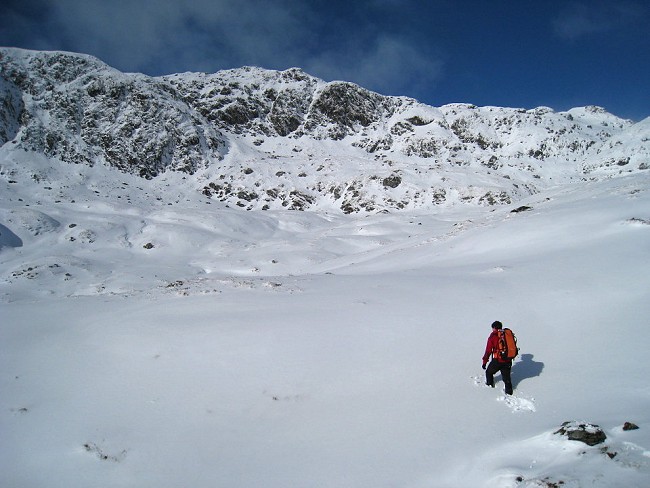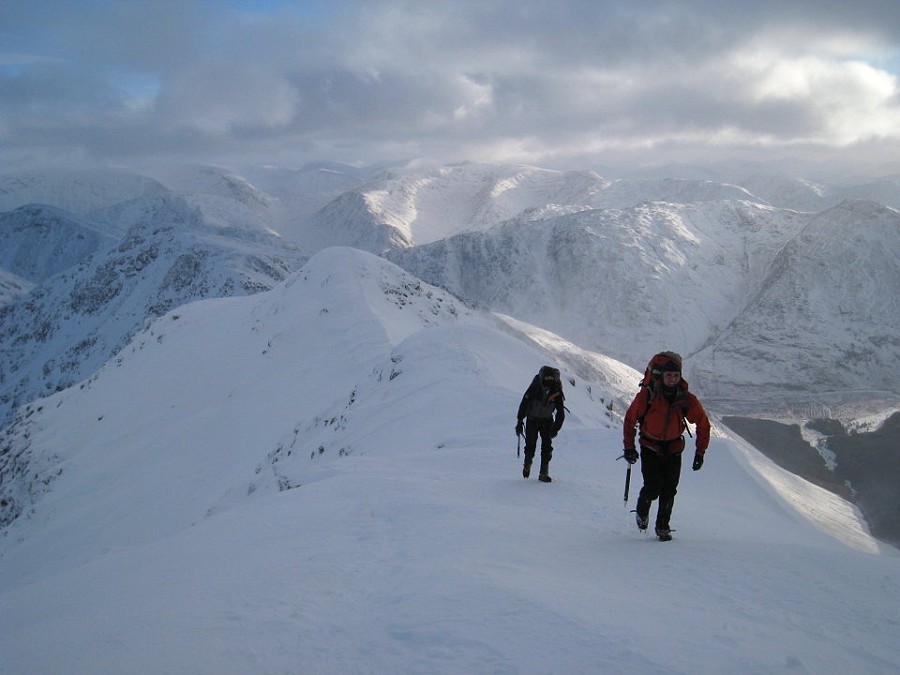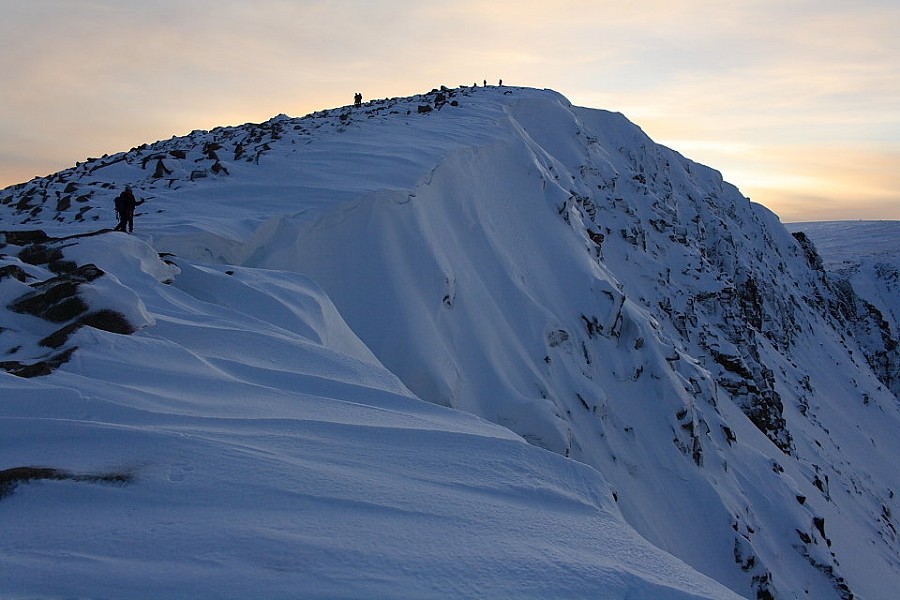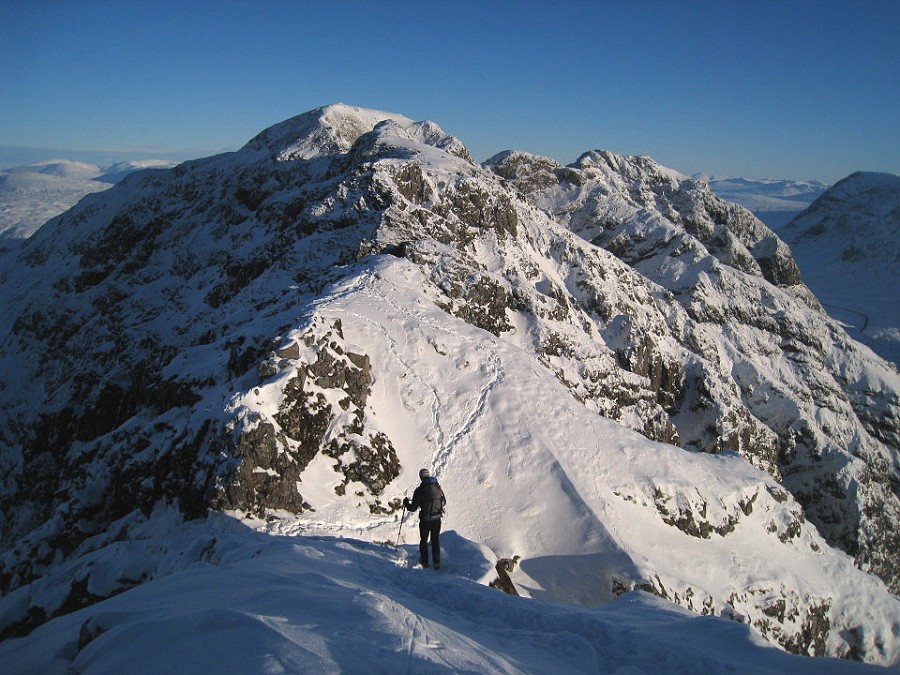Essentials for Beginners Part 3
Winter Essentials Part One offered a general introduction to the winter hills, while Winter Essentials Part Two covered clothing and equipment. The final instalment of this three-part series looks at some of the hazards, and the skills needed to keep you safe.
Avalanches, white-outs, wild weather, hypothermia, river crossings - winter hillwalking is a high stakes game, but there are measures you can take to minimise the risks. If you're sensible in the hills the most dangerous part of your day will probably be the drive. Part two of this series looked at clothing and equipment, and while the correct kit is very important a bag load of the latest shiny stuff is no subsititue in itself for knowledge and awareness. This final instalment in the series is a basic intro to core hill skills and key winter hazards. Check out the links for more detailed info.
Fitness
A hillwalk in the snow is likely to be far more physical than the same route in summer. Aerobic fitness and endurance are key, as is the mental resilience to shrug off bad weather or deep cloying snow. In foul conditions it's wise not to push on right to the limit; keep something in reserve just in case. The middle of nowhere in a blizzard is no place to realise you're exhausted. The best training for winter hillwalking is - you guessed it - lots of hillwalking. Summer backpacking and mega peak bagging missions will stand you in good stead; long runs are useful too, if you're a fan of lycra. If you're new to winter hills then start with manageable routes and break yourself in gently, at least until you've sussed out your physical abilities in this harsh and unfamiliar environment.
Navigation
Errors in navigation are implicated in a large proportion of mountain rescue incidents, with lost or overdue parties running at about 20% of annual call-outs in England and Wales over the last few years, for instance. It's a particularly critical issue in the dark days and wild weather of winter, when the consequences of mistakes can be most serious. The fundamentals of navigation are the same year-round, but this season can be especially demanding. Imagine trying to read a map when the wind is threatening to rip it from your frozen fingers and blasting hail into your eyes.
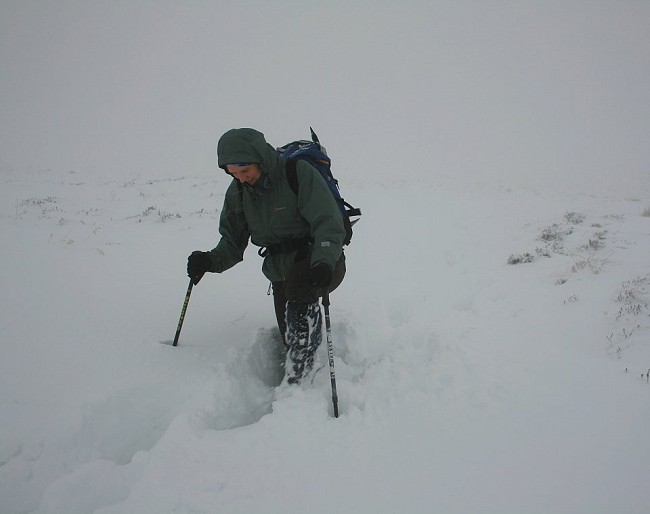
In poor visibility visual orientation falls away and bedrock skills such as following a bearing, estimating distance travelled, interpreting contours and slope aspect come to the fore. Bear in mind that deep snow will obscure paths and may cover landmark features such as streams and lochans. One thing to particularly look out for in strong wind is the tendency to veer from the course of a bearing.
Navigation Articles
For some handy tips on navigation see these UKH Articles:
Could you confidently cross a featureless plateau in a white-out using just a map and compass, with dusk fast approaching and corniced corrie edges lurking unseen somewhere out there? Key navigation skills need to be particularly well practised so that they're second nature when you're up against it. Build familiarity in good weather first, and maybe consider enrolling on a course. Winter-specific navigation courses are offered by Plas y Brenin and Glenmore Lodge, among others.
These days it's tempting to bypass all the old fashioned faff and rely entirely on GPS technology, but this would be asking for trouble. Since cold, wet or gremlins might get to your GPS at an inopportune moment a backup map and compass should always be carried. The simplicity of the map-and-compass system is its strong point; it is cheaper, lighter, and has less to go wrong. Pair these with an altimeter and you've a pretty comprehensive navigation solution - and if you're well versed in this then why bother with a GPS at all? GPS fans might counter that only they have a quick 100% accurate way to establish position in any weather; they might also suggest that in really challenging high-stress conditions the most fallible part of the system is the human element, and the margin for error is likely to be smallest with a GPS in hand. You can carry the technology without having to slavishly rely on it after all. There is no single right answer - go with whatever works for you.
Cold, wet and windy
Average winter temperatures are far lower in continental mountains like the Alps than in our soggy little hills - but managing body temparature and moisture can actually be easier in stable cold dry conditions. By contrast Britain's maritime climate poses a special challenge all its own, our usual combination of wet and wind creating an effective experienced temperature far lower than the thermometer value would suggest. Lucky us. In all-day driving rain and high humidity even the best waterproofs begin to show their limitations, and once you're wet, tired and perhaps a little under-fuelled then you're likely to feel pretty chilly. Add an unplanned delay - through injury or navigation error, say - and hypothermia is a danger. This condition sets in once the body's core temperature drops below 35 degrees, and if the heat loss isn't checked it's a killer. Warning signs include shivering, poor coordination and confusion - though you shouldn't let it get that far. For more on hypothermia see this article on the MCofS website. Aside from adequate clothing and nutrition your best defence from the cold is to keep moving, but if this proves impossible then seek shelter asap. Knowing how to construct an emergency snow shelter could be a life saver - see this UKH article.
As a cooling body seeks to conserve core heat blood is sucked from the extremities, leaving them exposed to the possiblity of superficial frostnip or even full-on frostbite, which can cause permanent damage to skin and other tissues. In extreme cases affected body parts may have to be amputated. Walkers who are properly clothed and able to keep moving probably don't have much to fear, but if you're immobilised through injury or even simply lose your gloves on a windy day then it may be a different story.
All the moisture sloshing around our hills has to end up in burns and rivers at some point, and in heavy rainfall or rapid snowmelt brought on by sudden thaws river crossing can be a real issue. On a wet day water levels may rise dramatically, and in spate even normally benign streams can range from hazardous to impassable. If the weather forecast suggests high water plan a route that involves fewer stream crossings. When met with a burn in full flow it may be wiser to make a lengthy detour than attempt a sketchy crossing. Head upstream where the volume is divided into tributaries; look for broad shingly shallows with no major hazards immediately downstream; even double check the map in case there's a footbridge you've missed. Once you've decided to cross then consider stripping off, and certainly stash all spare clothes in a dry bag; it's often better to wear boots to protect feet from rolling rocks. Unfasten rucksack buckles so your bag doesn't drag you under. Cross as a group with the largest person upstream. You'll really appreciate trekking poles - particularly if walking solo.
Avalanche
Winter walkers ignore the threat of avalanches at their peril. If you imagine these are only a danger in the Alps or Himalaya then think again; all it takes is sufficient snow, an incline and an instability in the snowpack. Our wild fluctuations in temperature and snowfall can result in some pretty hairy conditions in the British winter hills, and serious injuries and fatalities occur all too often. The Scottish Highlands inevitably have the lion's share of incidents, but by no means a monopoly. Check out last season's UKC news from the suburban Pentlands near the Edinburgh ring road, or Jan 2010's report from Snowdonia. It's salutary to note that the worst avalanche disaster in British history took place not in the Cairngorms but in the South Downs town of Lewes in 1836 when a row of houses was wiped out with the loss of eight lives.
popin(900,137961,TRUE,"center")?>
Don't leave home without an avalanche forecast – if there's one available for the area you're in, that is. In season, the Sportscotland Avalanche Information Service (SAIS) provides daily forecasts of avalanche risk and snow conditions reports from five popular mountain areas, Glen Coe, Lochaber, Creag Meagaidh, Northern Cairngorms and Southern Cairngorms. Reliable information in England and Wales is much harder to come by, with the only remotely comparable service being the Lake District Weatherline's seasonal daily felltop weather and ground conditions reports from Helvellyn.
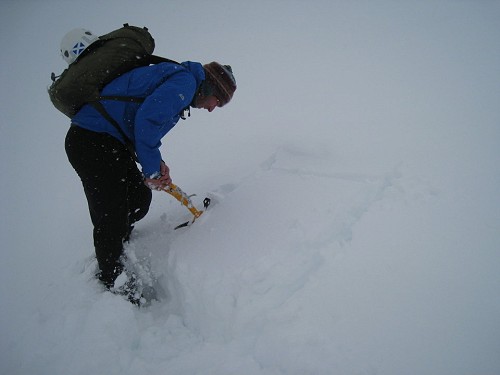
Outwith report areas you are obviously very much on your own, but personal judgement is required wherever you are. Reports are a supplement to your own decision making, not a substitute for it. No forecast is set in stone, and even 'low risk' doesn't mean no risk. It's sensible to study the weather patterns for a few days prior to heading out, noting how much snow may be falling on the hills, the lee aspects on which untrustworthy windborne accumulations might be expected, and the chance of sudden thaws. Avoid these wherever possible, noting too that mountain topography can often channel wind in unexpected directions. When out keep tabs on the stability of the snowpack, and don't be shy about changing plans if there's a reasonable doubt. Don't die of ignorance. Consider a dedicated avalanche awareness/avoidance course such as those offered by Glenmore Lodge or the MCofS.
What if the worst happens despite your best precautions? Even a small slide could knock you off your feet and carry you over a crag, while anyone caught in a larger avalanche could be completely buried. If buried, an avalanche victim's odds of survival rapidly diminish. Immediate rescue by members of their own party is their best shot, since by the time outside help arrives it could be too late. Ski tourers routinely wear avalanche transceivers, radio units which fulfil a dual function – emitting or receiving a pulse, so that if one member of a team is avalanched their friends can home in on their location. Avalanche probes and shovels are also essential parts of this system. Though it's not generally the done thing, a strong case can be made for the use of transceivers in winter hillwalking too. As ever, lots of practise would be needed before doing it for real. Glenmore Lodge recently opened the world's first year-round artificial Avalanche Transceiver Training Park, which is open for public booking.
For more info on avalanches check out this article from the MCofS.
Cornices
Wind-borne snow blows over summits and plateaux to build up as cornices along the edges of corries and ridges. These can be overhanging and unstable, and if you don't want to find yourself suddenly treading air it's wise to stay well back from any suspect edges, particularly as the fracture line for a breaking cornice might even extend onto supposedly safe ground. They are easily avoided in good visibility, but a menace in thick mist or whiteout. It's not unheard of to rope up when crossing a snowbound plateau to safeguard against an unexpected ride with a falling cornice. In thaw conditions it may not be clever to climb below a cornice since all that heavy snow has to drop some time...
Winter climbing grades
In winter conditions basic-but-dramatic summertime walker's ridges such as Striding Edge and the Carn Mor Dearg Arête become grade mountaineering I excursions, while higher end scrambles like An Teallach or Aonach Eagach can turn into pretty exciting grade II climbing adventures. For a few more ideas along these lines see this UKH winter ridges feature.
Many harder hillwalks will have short sections that become borderline mountaineering in certain snow or ice conditions, but as a general rule don't set out to tackle anything with a winter climbing grade, as expressed in Roman numerals, unless you're properly equipped and know what you're getting yourself into. So what do these numbers mean? Grade I is very basic climbing, one axe and a head for heights kind of ground but certainly the sort of terrain on which you'll feel you've crossed the line from walking into full-on fall-off-able mountaineering. Grade II is a big step up the ladder in terms of steepness, technicality and seriousness, routes on which many people will want a pair of climbing axes and a rope. The grading scale is open-ended and currently runs up to about X, but that's a discussion for our sister site UKC. Even the move from I to II takes us beyond the scope of a hillwalking article.
Courses, instructors and lectures
Whether you're just starting out in winter or a more experienced walker looking to top up your skills, there are plenty of courses and lectures at your disposal. For those who do a lot of walking north of the border the Mountaineering Council of Scotland (MCofS) could be a good first port of call.
'The MCofS is working hard to reduce the number of people getting into difficulty in the Scottish Hills this winter' says Heather Morning, Mountain Safety Advisor for the MCofS. 'If you are thinking of venturing out above the snow line to enjoy our fantastic winter mountains, our range of winter courses are great value for money and a superb way of equipping people with the skills they need to enjoy the hills safely.'
General winter skills and safety courses are also offered by a number of other providers too of course, including the national outdoor centres Glenmore Lodge and Plas y Brenin - who also run subsidised winter mountaineering courses for young people through the Jonathan Conville Memorial Trust.
An alternative to a course is a trip with an instructor or mountain guide. These can be tailored to your personal needs, and by splitting the cost among a group of friends bespoke days out may turn out no more expensive than a course. To find a freelance instructor visit the Association of Mountaineering Instructors (AMI) website, or the British Mountain Guides (BMG) website.
In addition to these sources of skills training the BMC and the MCofS both run regular lectures and workshops on winter safety and skills.
Further reading
Winter Skills: Essential Walking & Climbing Techniques, Andy Cunningham & Allen Fyffe (UKMTB)
The Mountain Skills Training Handbook, Pete Hill and Stuart Johnson (David & Charles)
Scotland's Winter Mountains, Martin Moran (David & Charles) - out of print and a little outdated in places but still the most inspiring and comprehensive general introduction to Scottish winter walking and mountaineering. Copies can be found 2nd hand.
articles_author() ?>


